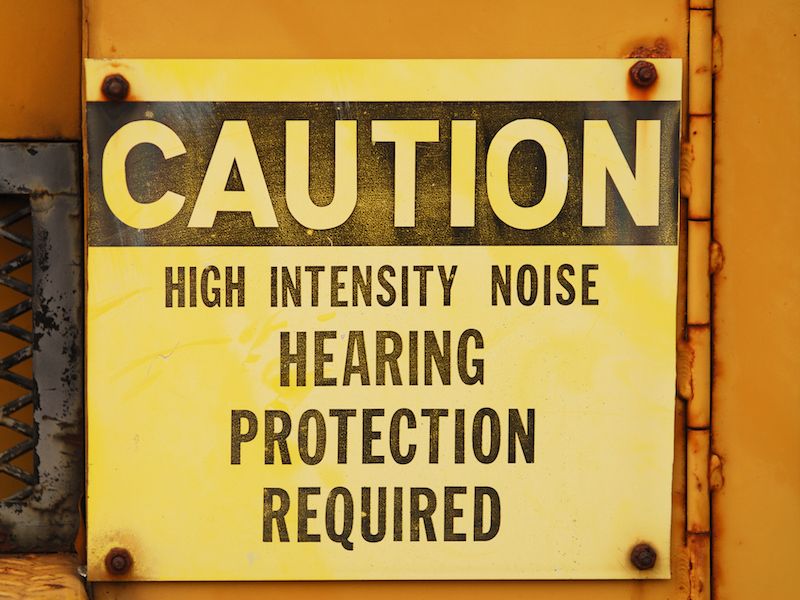
Knowing you need to safeguard your ears is one thing. Knowing when to safeguard your ears is another matter. It’s not as simple as, for example, recognizing when to use sunscreen. (Is it sunny and will you be outdoors? Then you need sunscreen.) Even recognizing when you need eye protection is simpler (Using a hammer? Cutting some wood or working with hazardous chemicals? Wear eye protection).
It can feel as though there’s a significant grey area when dealing with when to use ear protection, and that can be dangerous. Unless we have particular information that some place or activity is hazardous we tend to take the easy road which is to avoid the issue entirely.
Determining The Risks
In general, we’re not very good at assessing risk, especially when it comes to something as intangible as damage to the ears or the probability of permanent sensorineural hearing loss. Let’s take some examples to prove the point:
- Person A attends a very loud rock concert. The concert lasts around 3 hours.
- A landscaping business is run by person B. She spends a considerable amount of time mowing lawns, then she goes home to a quiet house and reads.
- Person C is an office worker.
You may presume that person A (let’s call her Ann, to be a little less clinical) might be in more hearing danger. Ann leaves the concert with ringing ears, and she’ll spend the majority of the next day, struggling to hear herself speak. Assuming Ann’s activity was hazardous to her hearing would be reasonable.
The noise that person B (let’s just call her Betty), is subjected to is not as loud. There’s no ringing in her ears. So her ears must be less hazardous, right? Not necessarily. Because Betty is mowing all day. So even though her ears never ring out with pain, the damage builds up bit by bit. Even moderate sounds, if experienced with enough frequency, can injury your hearing.
Person C (let’s call her Chris) is even less evident. Lawnmowers have instructions that point out the risks of long-term exposure to noise. But although Chris has a fairly quiet job, her long morning commute on the train every day is fairly loud. What’s more, she sits behind her desk and listens to music through earbuds. Does she need to give some thought to protection?
When is it Time to be Concerned About Protecting Your Hearing?
The standard rule of thumb is that if you have to raise your voice to be heard, your surroundings are loud enough to do damage to your ears. And you should think about wearing earplugs or earmuffs if your surroundings are that loud.
If you want to think about this a bit more clinically, you need to use 85dB as your cutoff. Noises above 85dB have the potential to cause damage over time, so you should think about using hearing protection in those scenarios.
Many hearing specialists recommend getting a specialized app to monitor noise levels so you will be cognizant of when the 85dB has been reached. You will be able to take the necessary steps to safeguard your hearing because these apps will tell you when the noise is approaching a hazardous volume.
A Few Examples
Your phone may not be with you wherever you go even if you do download the app. So we may formulate a good standard with a few examples of when to protect our hearing. Here we go:
- Domestic Chores: Even mowing a lawn, as previously mentioned, calls for hearing protection. Cutting the grass is a great example of the type of household job that may cause harm to your ears but that you probably won’t think about all that often.
- Driving & Commuting: Do you drive for Lyft or Uber? Or maybe you’re just hanging out downtown for work or boarding the train. The constant noise of living in the city, when experienced for between 6 and 8 hours a day, can cause damage to your ears over the long haul, particularly if you’re turning up your music to hear it over the din.
- Listening to music with earbuds. OK, this doesn’t require protection but does require caution. Pay attention to how loud the music is, how long you’re playing it, and whether it’s going directly into your ears. Noise-canceling headphones are a smart choice to avoid needing to turn the volume way up.
- Exercise: Your morning cycling class is a good example. Or perhaps your daily elliptical session. Each of these examples might call for ear protection. The high volume from instructors who play loud music and microphones for motivation, though it might be good for your heart rate, can be bad for your ears.
- Using Power Tools: You recognize that working all day at your factory job will require hearing protection. But what if you’re just puttering around your garage all day? Most hearing professionals will suggest you use hearing protection when operating power tools, even if it’s only on a hobbyist basis.
These illustrations might give you a good baseline. When in doubt, though, you should defer to protection. In the majority of cases, it’s better to over-protect your hearing than to leave them subject to possible harm down the road. Protect today, hear tomorrow.